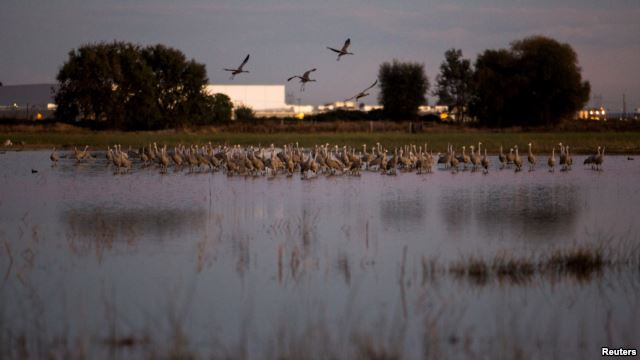
But the state's ongoing drought has left the cranes, along with millions of other waterfowl that migrate from Canada and other northern climes to spend the winter in California, with fewer places to land, threatening their health as they crowd in on one another to seek shelter and food.
"They're left with fewer and fewer places to go, which will start to have impacts on their population," said Meghan Hertel, who works on habitat issues for the Audubon Society in California. "They can die here from starvation or disease or be weaker for their flight back north."
Beloved sight
The cranes are a beloved sight in California's Sacramento and San Joaquin Valleys when they arrive each fall.
Tourists flock to see them as they take off en masse at dawn or land in a series of swooping, trilling groups as the sun goes down.
This weekend, the town of Lodi near the Sacramento-San Joaquin River Delta holds its annual crane festival, complete with tours of the wetlands where the five-foot tall birds spend their days foraging for food and their nights roosting in shallow water.
California's Central Valley - which includes both the San Joaquin and the Sacramento - provides winter lodging for 60 percent of the world's 10,000 remaining greater Sandhill Cranes, a taller crane variety that is listed as a threatened species by the state, according to the Audubon Society.
As many as 25,000 of their shorter cousins, the lesser Sandhill Cranes, also roost in the region.
But the wildlife refuges set up to replace natural habitat long diminished by the dams and levees built by humans in the most-populous U.S. state are themselves drier this year, and fewer acres of wetland are available to the birds.
Drought efforts
And in an ironic twist, farmers criticized by some conservationists for flooding their corn, rice and alfalfa fields have cut back the practice dramatically as the drought has worn on, saving water but reducing habitat for waterfowl, who rely on the wet acreage to roost and feed.
"The impact of not having flooded agricultural fields available to the birds is huge," said Craig Isola, deputy project leader for the Sacramento National Wildlife Refuge Complex.
In the Sacramento Valley north of the Delta, flooded fields rich with unused grain, insects and other nutrients supply half of the food eaten by migratory birds each year, Isola said.
But this year, rice farmers plan to flood just 100,000 of the 300,000 acres that they normally cover with about five inches of water, said Paul Buttner, environmental affairs manager for the California Rice Commission.
Wetland acreage is also down at the wildlife refuges managed by state and federal agencies.
That's because even though the refuges are located in areas that were once natural wetlands, the water that would have flowed to them a century or more ago has long since been blocked by dams, levees and reservoirs meant to help manage water for a state that has grown to include 39 million residents.
As a result, the refuges receive an allocation of water each year from regional water suppliers, which they then use to flood their lands just in time for migratory birds to come in the fall.
Supply cut to refuges
The state's catastrophic drought, now in its fourth year, led the regulators who manage California's water supply to cut back the allocation for the refuges by up to 45 percent for 2015.
Rain is expected to help ease conditions in the southern part of the state, thanks to the weather and Pacific Ocean warming phenomenon known as El Nino, relief that would also provide more wet habitat for migratory birds.
But El Nino doesn't always bring rain as far north as the Sacramento Valley or the Delta area, so there is a chance that dry conditions will linger here.
If that happens, the cranes, ducks, geese and other migratory birds that winter in the state's midsection would have to crowd in to dramatically smaller wetland areas, making it easier to spread of such diseases as avian cholera.
"If a disease outbreak occurs we could lose a lot more of them than we would in a normal year," said Dan Yparraguirre, deputy director of the California Department of Fish and Wildlife.
Birds might also be weakened by a lack of food. "They will have less access to food and poorer body condition come spring, then when they migrate north they may not make it," he said.



The rainy season has started in California, and it looks it will be record-high rainfall all over the state, thanks to the biggest El Nino in recorded history. But SOTT keeps banging the drought-drum, no matter what happens here, no matter how much rain we get in California.
Give it up.